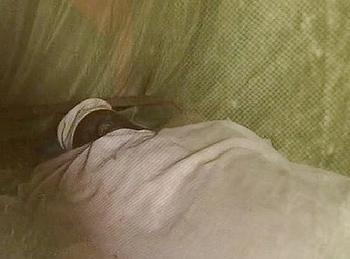
LONDON, UK, September 21, 2012 (ENS) – A “dangerous” new malaria-transmitting mosquito has been discovered in Kenya by British, Kenyan and U.S. scientists. As yet unnamed, the newly-found species has never before been implicated in the transmission of malaria.
It poses a threat because it bites humans at times when they are not protected by techniques now used to control malaria, a blood disease that kills nearly one million people each year. Malaria is caused by Plasmodium parasites that are spread to people through mosquito bites.
The common and well-known Anopheles mosquitoes that transmit malaria in Africa prefer to rest indoors during the day and feed on humans at night. This behavior led to current malaria control programs such as spraying insecticide in homes and issuing insecticide-treated bed nets for people to sleep under.

But this new mosquito is active outdoors and bites people earlier in the evening soon after sunset.
“We observed that many mosquitoes we caught, including those infected with malaria, did not physically resemble other known malaria mosquitoes,” said lead author Jennifer Stevenson, research fellow at the London School of Hygiene & Tropical Medicine. “Analysis indicated that their DNA differed from sequences available for known malaria-transmitting mosquitoes in Africa.”
“These unidentified mosquitoes are potentially dangerous because they are outdoor-active and early-biting, and so may evade the current indoor-based interventions to control mosquitoes,” said Stevenson.
“In this way,” she said, “they may prevent the complete suppression of malaria transmission in the area.”
Malaria is the leading cause of death in Kenya, with 25 million out of a population of 34 million Kenyans at risk of the disease.
Across sub-Saharan Africa, a child dies of malaria every 45 seconds. In 2009, children under five accounted for 85 percent of the nearly 800,000 malaria deaths in the region.
The study, published in the current issue of the journal “Emerging Infectious Diseases,” details how researchers set up indoor and outdoor mosquito traps in a village in Kisii in the highlands of western Kenya, an area with seasonal and unstable malaria transmission.
Over 65 percent of mosquitoes caught were outdoors, the majority before 10:30 pm. The scientists identified 348 mosquitoes using DNA sequencing techniques – of these over 40 percent were found to be of this unidentified species.

Five mosquitoes of this species were carrying malaria parasites and two had fed on humans.
“Data we have collected on human sleeping patterns from this area suggest that a significant proportion of the population is still outdoors before 10:30 pm and therefore exposed to these vectors,” the scientists wrote in their study.
Jo Lines, a former coordinator for the World Health Organization’s Global Malaria Programme, said, “These findings remind us that the basic biology of malaria transmission is subtle and complex: there are still plenty of gaps in our knowledge, and local variations that we do not understand. We do not yet know what these unidentified specimens are, or whether they are acting as vectors on a wider scale, but in the study area they are clearly playing a major and previously unsuspected role.”
“The practical implication for malaria control programs is that there is no substitute for careful monitoring of mosquito populations. In order to be effective, such monitoring must be carried out by specialist experts who have the skills to recognise and investigate unexpected entomological observations,” said Lines, who now works with the Malaria Control and Vector Biology program at the London School of Hygiene & Tropical Medicine.
The scientists write in their study, “Cryptic species or subpopulations that exhibit divergent behaviors may be responsible for maintaining malaria parasite transmission, and without adequate discriminatory techniques, these vectors may be misidentified and their key behavioral differences overlooked.”
They are calling for increased surveillance and a focus on integrating a wider range of malaria control tools to deal with the threat of outdoor malaria transmission.
The researchers cautioned that as these mosquitoes have so far been seen only in one location in Kenya, it is essential that tourists still protect themselves with a mosquito net treated with a long-lasting insecticidal treatment while travelling.
The research was carried out in collaboration with the Kenya Medical Research Institute under the Malaria Transmission Consortium, funded by the Bill and Melinda Gates Foundation.
The study is entitled, “Novel Vectors of Malaria Parasites in the Western Highlands of Kenya.” Authors are: Jennifer Stevenson, Mary K. Cooke, Jonathan Cox, Chris Drakeley (London School of Hygiene & Tropical Medicine); Brandyce St. Laurent, Neil F. Lobo (University of Notre Dame); Samuel C. Kahindi, Robin M. Oriango (Kenya Medical Research Institute, Centre for Global Health Research, Kisumu); Ralph E. Harbach (Natural History Museum, London). Published in “Emerging Infectious Diseases.”
Copyright Environment News Service (ENS) 2012. All rights reserved.
© 2012, Environment News Service. All rights reserved. Content may be quoted only with proper attribution and a direct link to the original article. Full reproduction is prohibited.
